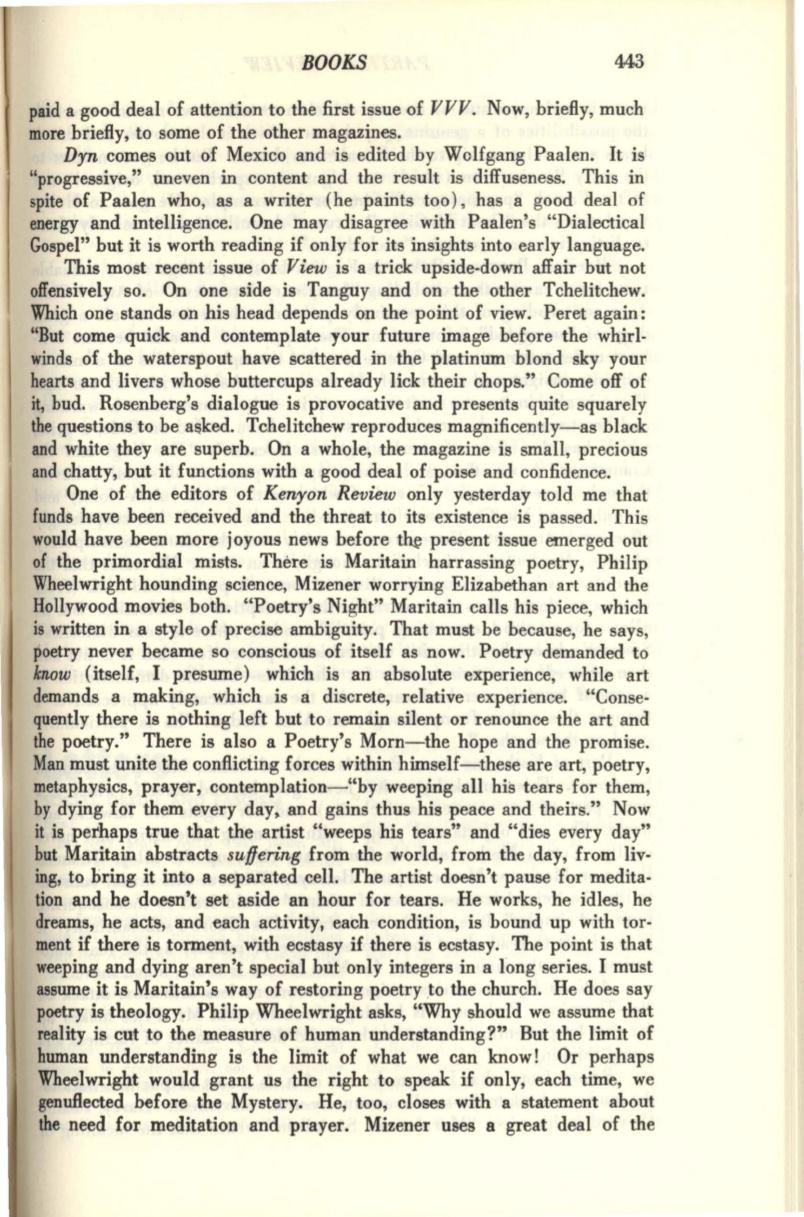
BOOKS
443
paid a good deal of attention to the first issue of
VVV.
Now, briefly, much
more briefly, to some of the other magazines.
Dyn
comes out of Mexico and is edited by Wolfgang Paalen.
It
is
"progressive," uneven in content and the result is diffuseness. This in
spite of Paalen who, as a writer (he paints too), has a good deal of
energy and intelligence. One may disagree with Paalen's "Dialectical
Gospel" but it is worth reading
if
only for its insights into early language.
This most recent issue of
View
is a trick upside-down affair but not
offensively so. On one side is Tanguy and on the other Tchelitchew.
Which one stands on his head depends on the point of view. Peret again:
"But come quick and contemplate your future image before the whirl–
winds of the waterspout have scattered in the platinum blond sky your
hearts and livers whose buttercups already lick their chops." Come off of
it,
bud. Rosenberg's dialogue is provocative and presents quite squarely
the questions to be a!lked. Tchelitchew reproduces magnificently-as black
and white they are superb.
On
a whole, the magazine is small, precious
and chatty, but it functions with a good deal of poise and confidence.
One of the editors of
Kenyon Review
only yesterday told me that
funds have been received and the threat to its existence is passed. This
would have been more joyous news before the present issue emerged out
of the primordial mists. There is Maritain harrassing poetry, Philip
Wheelwright hounding science, Mizener worrying Elizabethan art and the
Hollywood movies both. "Poetry's Night" Maritain calls his piece, which
is written in a style of precise ambiguity. That must be because, he says,
poetry never became so conscious of itself as now. Poetry demanded to
/mow
(itself, I presume) which is an absolute experience, while art
demands a making, which is a discrete, relative experience. "Conse–
quently there is nothing left but to remain silent or renounce the art and
the poetry." There is also a Poetry's Morn-the hope and the promise.
Man must unite the conflicting forces within himself-these are art, poetry,
metaphysics, prayer, contemplation-"by weeping all his tears for them,
by dying for them every day, and gains thus his peace and theirs." Now
it is perhaps true that the artist "weeps his tears" and "dies every day"
but Maritain abstracts
suffering
from the world, from the day, from liv–
ing, to bring it into a separated cell. The artist doesn't pause for medita–
tion and he ·doesn't set aside an hour for tears. He works, he idles, he
dreams, he acts, and each activity, each condition, is bound up with tor–
ment if there is torment, with ecstasy if there is ecstasy. The point is that
weeping and dying aren't special but only integers in a long series. I must
assume it is Maritain's way of restoring poetry .to the church. He does say
poetry is theology. Philip Wheelwright asks, "Why should we assume that
reality is cut to the measure of human understanding?" But the limit of
human understanding is the limit of what we can know! Or perhaps
Wheelwright would grant us the right to speak if only, each time, we
genuflected before the Mystery. He, too, closes with a statement about
the need for meditation and prayer. Mizener uses a great deal of the


